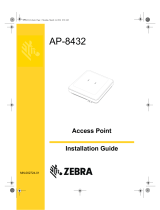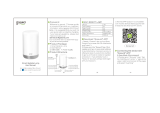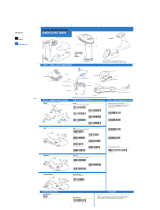
Wireless Gateway
Zebra reserves the right to make changes to any product to improve
reliability, function, or design. Zebra does not assume any product liability
arising out of, or in connection with, the application or use of any product,
circuit, or application described herein. No license is granted, either
expressly or by implication, estoppel, or otherwise under any patent right or
patent, covering or relating to any combination, system, apparatus,
machine, material, method, or process in which Zebra products might be
used. An implied license exists only for equipment, circuits, and
subsystems contained in Zebra products.
Warranty
For the complete Zebra hardware product warranty statement, go to:
http://www.zebra.com/warranty.
Service Information
Before you use the unit, it must be configured to operate in your facility’s
network and run your applications.
If you have a problem running your unit or using your equipment, contact
your facility’s Technical or Systems Support. If there is a problem with the
equipment, they will contact the Zebra Global Customer Support at
http://www.zebra.com/support.
For the latest version of this guide go to: http://www.zebra.com/support.
Zebra Technologies Corporation
Lincolnshire, IL USA
http://www.zebra.com
© 2017 ZIH Corp and/or its affiliates. All rights reserved. ZEBRA and the
stylized Zebra head are trademarks of ZIH Corp, registered in many
jurisdictions worldwide. All other trademarks are the property of their
respective owners.
9160 G2
Regulatory Guide
MN-002804-02 Revision A — May 2017
Regulatory Information
This device is approved under Zebra Technologies Corporation.
This guide applies to Model Number 9160 G2.
All Zebra devices are designed to be compliant with the rules and
regulations in the locations they are sold and will be labeled as
required.
Local language translations are available at the following website:
http://www.zebra.com/support.
Any changes or modifications to Zebra equipment not expressly
approved by Zebra could void the user's authority to operate the
equipment.
Zebra devices are professionally installed - the Radio Frequency
Output Power will not exceed the maximum allowable limit for the
country of operation.
Wireless Device Country Approvals
Regulatory markings subject to certification are applied to the
device signifying the radio is approved for use in the following
countries and continents: United States, Canada, Australia, and
Europe.
Please refer to the Declaration of Conformity (DoC) for details of
other country markings. This is available at:
http://www.zebra.com/doc.
Note: Europe includes Austria, Belgium, Bulgaria, Croatia, Czech
Republic, Cyprus, Denmark, Estonia, Finland, France, Germany,
Greece, Hungary, Iceland, Ireland, Italy, Latvia, Liechtenstein,
Lithuania, Luxembourg, Malta, Netherlands, Norway, Poland,
Portugal, Romania, Slovak Republic, Slovenia, Spain, Sweden,
Switzerland, and the United Kingdom.
Country Roaming
Frequency license is required in the country of use. Without this
license the operation of this device illegal.
Health and Safety Recommendations
Ergonomic Recommendations
•
Reduce or eliminate repetitive motion
•
Maintain a natural position
•
Reduce or eliminate excessive force
•
Keep objects that are used frequently within easy reach
•
Perform tasks at correct heights
•
Reduce or eliminate vibration
•
Reduce or eliminate direct pressure
•
Provide adjustable workstations
•
Provide adequate clearance
•
Provide a suitable working environment
•
Improve work procedures.
Potentially Hazardous Atmospheres – Fixed
Installations
You are reminded of the need to observe restrictions on the use
of radio devices in fuel depots, chemical plants etc. and areas
where the air contains chemicals or particles (such as grain, dust,
or metal powders).
Wireless devices transmit radio frequency energy and may affect
medical electrical equipment. When installed adjacent to other
equipment, it is advised to verify that the adjacent equipment is
not adversely affected.
Pacemakers
Pacemaker manufacturers recommended that a minimum of 15
cm (6 inches) be maintained between a handheld wireless device
and a pacemaker to avoid potential interference with the
pacemaker. These recommendations are consistent with
independent research and recommendations by Wireless
Technology Research.
Persons with Pacemakers:
•
Should ALWAYS keep the device more than 15cm (6 inches)
from their pacemaker when turned ON.
•
Should not carry the device in a breast pocket.
•
Should use the ear furthest from the pacemaker to minimize
the potential for interference.
•
If you have any reason to suspect that interference is taking
place, turn OFF your device.
Other Medical Devices
Please consult your physician or the manufacturer of the medical
device to determine if the operation of your wireless product may
interfere with the medical device.
RF Exposure Guidelines
Safety Information
Reducing RF Exposure – Use Properly
Only operate the device in accordance with the instructions
supplied.
International
The device complies with internationally recognized standards
covering human exposure to electromagnetic fields from radio
devices. For information on 'International' human exposure to
electromagnetic fields, refer to the Zebra Declaration of
Conformity (DoC) at http://www.zebra.com/doc.
For further information on the safety of RF energy from wireless
devices, see
https://www.zebra.com/us/en/about-zebra/company-information/
corporate-responsibility.html located under Corporate
Responsibility.
Europe
Remote and Standalone Antenna Configurations
To comply with EU RF exposure requirements, antennas that are
mounted externally at remote locations or operating near users at
stand-alone desktop of or similar configurations must operate
with a minimum separation distance of 20 cm from all persons.
Remote and Standalone Antenna Configurations
To comply with FCC RF exposure requirements, antennas that
are mounted externally at remote locations or operating near
users at stand-alone desktop of or similar configurations must
operate with a minimum separation distance of 20 cm from all
persons.
Access Points - Antenna Configuration (US Only)
Configuration of the antenna's elevation gain: Antenna gain is the
ratio of an antenna's radiation intensity in a given direction to the
intensity produced by a no-loss, isotropic antenna radiating
equally in all directions. An antenna's gain along the horizon and
at an elevation of 30 degree may vary. The elevation gain is
defined as the maximum antenna gain at 30 to 150 degrees
above the horizon. If elevation gain is configured, the transmit
(TX) power calculations maximize the allowable TX power for an
elevation below 30 degree.
Access Points must conform to U.S. Federal Communications
Commission's (FCC) limitations. FCC has now stipulated a
21dBm EIRP limit for power directed 30 degrees above the
horizon.
Radio Frequency Interference Requirements-FCC
Note: This equipment has been tested and
found to comply with the limits for a Class B
digital device, pursuant to Part 15 of the FCC
rules. These limits are designed to provide
reasonable protection against harmful interference in a
residential installation. This equipment generates, uses and can
radiate radio frequency energy and, if not installed and used in
accordance with the instructions, may cause harmful interference
to radio communications. However there is no guarantee that
interference will not occur in a particular installation. If this
equipment does cause harmful interference to radio or television
reception, which can be determined by turning the equipment off
and on, the user is encouraged to try to correct the interference
by one or more of the following measures:
•
Reorient or relocate the receiving antenna
•
Increase the separation between the equipment and receiver
•
Connect the equipment into an outlet on a circuit different from
that to which the receiver is connected
•
Consult the dealer or an experienced radio/TV technician for
help.
Radio Transmitters (Part 15)
This device complies with Part 15 of the FCC Rules. Operation is
subject to the following two conditions: (1) this device may not
cause harmful interference, and (2) this device must accept any
interference received including interference that may cause
undesired operation.
Radio Frequency Interference Requirements-Canada
This Class B digital apparatus complies with Canadian CAN
ICES-3 (B)/NMB-3(B).
Cet appareil numérique de la classe B est conforme à la norme
CAN ICES-3 (B)/NMB-3(B) du Canada.
Radio Transmitters
This device requires Industry Canada's licence. Operation is
subject to the following two conditions: (1) This device may not
cause interference; and (2) This device must accept any
interference, including interference that may cause undesired
operation of the device.
Le présent appareil est conforme aux CNR d'Industrie Canada
applicables aux appareils radio de licence. L'exploitation est
autorisée aux deux conditions suivantes: (1) l'appareil ne doit pas
produire de brouillage, et (2) l'utilisateur de l'appareil doit
accepter tout brouillage radio électrique subi même si le
brouillage est susceptible d'en compromettre le fonctionnement.
For RLAN Devices:
In accordance with the regulations of Industry Canada, this radio
transmitter can operate with an antenna of a type and a
maximum gain (or lower) approved for the transmitter by Industry
Canada. With the aim of reducing the risk of radio interference to
other users, the chosen antenna type and it gain should be
selected so that the equivalent isotropically radiated power
(e.i.r.p.) does not exceed the intensity necessary for the
establishment of a satisfactory connection.
Conformément à la réglementation d'Industrie Canada, le présent
émetteur radio peut fonctionner avec une antenne d'un type et
d'un gain maximal (ou inférieur) approuvé pour l'émetteur par
Industrie Canada. Dans le but de réduire les risques de brouillage
radio électrique à l'intention des autres utilisateurs, il faut choisir
le type d'antenne et son gain de sorte que la puissance isotrope
rayonnée équivalente (p.i.r.e.) ne dépasse pas l'intensité
nécessaire à l'établissement d'une communication satisfaisante.
This radio transmitter has been approved by Industry Canada to
operate with the antenna types listed below and having a
maximum gain allowable and the impedance required for each
type of antenna. The antenna types not included in this list, or
whose gain is higher than the maximum gain indicates, are
strictly prohibited for the operation of the transmitter.
Le présent émetteur radio a été approuvé par Industrie Canada
pour fonctionner avec les types d'antenne énumérés ci-dessous
et ayant un gain admissible maximal et l'impédance requise pour
chaque type d'antenne. Les types d'antenne non inclus dans
CAUTION Use only the supplied or an approved replacement
antenna. Unauthorized antennas, modifications, or
attachments could cause damage and may violate
regulations.
CAUTION Operation of the device without regulatory
approval is illegal
CAUTION In order to avoid or minimize the potential risk of
ergonomic injury follow the recommendations
below. Consult with your local Health & Safety
Manager to ensure that you are adhering to your
company's safety programs to prevent employee
injury.

cette liste ou dont le gain est supérieur au gain maximal indiqué,
sont strictement interdits pour l'exploitation de l'émetteur.
Marking and European Economic Area (EEA)
The use of 5GHz RLAN’s throughout the EEA, have the following
restriction:
· 5.15 - 5.35 GHz is restricted to indoor use only.
The use of UHF narrow band devices may be subject to national
licensing requirements. Consult the national spectrum management
authority for advice before operating such devices.
Statement of Compliance
Zebra hereby declares that this radio equipment is in compliance
with Directives, 2014/53/EU and 2011/65/EU.
The full text of the EU Declaration of Conformity is available at
the following internet address: www.zebra.com/doc.
Japan (VCCI) - Voluntary Control Council for
Interference
Class B ITE
This is a Class B product based on the standard of the Voluntary
Control Council for Interference from Information Technology
Equipment (VCCI). If this is used near a radio or television
receiver in a domestic environment, it may cause radio
interference. Install and use the equipment according to the
instruction manual.
Korea Warning Statement for Class B ITE
Other Countries
警告
此为 A 级产品,在生活环境中,该产品可能会造成无形电干扰。在
这种情况下,可能需要用户对干扰采取切实可行的措施。
China
通过访问以下网址可下载当地语言支持的产品说明书
http://www.zebra.com/support
Eurasian Customs Union
Евразийский Таможенный Союз
Данный продукт соответствует требованиям знака EAC.
This product complies with the requirements of the EAC mark.
Taiwan
According to the Administrative Regulations on Low Power Radio
Waves Radiated Devices:
Article 12
Without permission granted by the DGT, any company,
enterprise, or user is not allowed to change frequency, enhance
transmitting power, or alter original characteristic as well as
performance to an approved low power radio-frequency devices.
Article 14
The low power radio-frequency devices shall not influence aircraft
security and interfere legal communications; If found, the user
shall cease operating immediately until no interference is
achieved.
The said legal communications means radio communications is
operated in compliance with the Telecommunications Act.
The low power radio-frequency devices must be susceptible with
the interference from legal communications or ISM radio wave
radiated devices.
臺灣
低功率電波輻射性電機管理辦法
第十二條
經型式認證合格之低功率射頻電機,非經許可,公司、商號或使
用者均不得擅自變更頻率、加大功率或變更原設計之特性及功能。
第十四條
低功率射頻電機之使用不得影響飛航安全及干擾合法通信;經發
現有干擾現象時,應立即停用,並改善至無干擾時方得繼續使用。
前項合法通信,指依電信規定作業之無線電通信。
低功率射頻電機須忍受合法通信或工業、科學及醫療用電波輻射
性電機設備之干擾。
Access Point (Professional installation):
•
「本公司於說明書中提供所有必要資訊以指導使用者 / 安裝者正
確的安裝及操作」警語。並於該中文使用說明書及器材上標示
•
「本器材須經專業工程人員安裝及設定,始得設置使用,且不
得直接販售給一般消費者」警語。
Turkey
Bu cihaz Türkçe karakterlerin tamamını ihtiva eden ETSI TS
123.038 V8.0.0 (veya sonraki sürümün kodu) ve ETSI TS
123.040 V8.1.0 (veya sonraki sürümün kodu) teknik özelliklerine
uygundur.
Ukraine
Дане обладнання відповідає вимогам технічного регламенту
№1057, № 2008 на обмеження щодо використання деяких
небезпечних речовин в електричних та електронних
пристроях.
Thailand
เครื่องโทรคมนาคมและอุปกรณนี้ มีความสอดคลองตามขอกําหนดของ
กทช .
Waste Electrical and Electronic
Equipment (WEEE)
English: For EU Customers: All products at the end of
their life must be returned to Zebra for recycling. For information
on how to return product, please go to:
http://www.zebra.com/weee.
Français: Clients de l'Union Européenne: Tous les produits en fin
de cycle de vie doivent être retournés à Zebra pour recyclage.
Pour de plus amples informations sur le retour de produits,
consultez : http://www.zebra.com/weee.
Español: Para clientes en la Unión Europea: todos los productos
deberán entregarse a Zebra al final de su ciclo de vida para que
sean reciclados. Si desea más información sobre cómo devolver
un producto, visite: http://www.zebra.com/weee.
Bulgarish: За клиенти от ЕС: След края на полезния им
живот всички продукти трябва да се връщат на Zebra за
рециклиране. За информация относно връщането на
продукти, моля отидете на адрес: http://www.zebra.com/weee.
Deutsch: Für Kunden innerhalb der EU: Alle Produkte müssen
am Ende ihrer Lebensdauer zum Recycling an Zebra
zurückgesandt werden. Informationen zur Rücksendung von
Produkten finden Sie unter http://www.zebra.com/weee.
Italiano: per i clienti dell'UE: tutti i prodotti che sono giunti al
termine del rispettivo ciclo di vita devono essere restituiti a Zebra
al fine di consentirne il riciclaggio. Per informazioni sulle modalità
di restituzione, visitare il seguente sito Web:
http://www.zebra.com/weee.
Português: Para clientes da UE: todos os produtos no fim de
vida devem ser devolvidos à Zebra para reciclagem. Para obter
informações sobre como devolver o produto, visite:
http://www.zebra.com/weee.
Nederlands: Voor klanten in de EU: alle producten dienen aan
het einde van hun levensduur naar Zebra te worden
teruggezonden voor recycling. Raadpleeg
http://www.zebra.com/weee voor meer informatie over het
terugzenden van producten.
Polski: Klienci z obszaru Unii Europejskiej: Produkty wycofane z
eksploatacji należy zwrócić do firmy Zebra w celu ich utylizacji.
Informacje na temat zwrotu produktów znajdują się na stronie
internetowej http://www.zebra.com/weee.
Čeština: Pro zákazníky z EU: Všechny produkty je nutné po
skonèení jejich životnosti vrátit spoleènosti Zebra k recyklaci.
Informace o zpùsobu vrácení produktu najdete na webové
stránce: http://www.zebra.com/weee.
Eesti: EL klientidele: kõik tooted tuleb nende eluea lõppedes
tagastada taaskasutamise eesmärgil Zebra'ile. Lisainformatsiooni
saamiseks toote tagastamise kohta külastage palun aadressi:
http://www.zebra.com/weee.
Magyar: Az EU-ban vásárlóknak: Minden tönkrement terméket a
Zebra vállalathoz kell eljuttatni újrahasznosítás céljából. A termék
visszajuttatásának módjával kapcsolatos tudnivalókért
látogasson el a http://www.zebra.com/weee weboldalra.
Svenska: För kunder inom EU: Alla produkter som uppnått sin
livslängd måste returneras till Zebra för återvinning. Information
om hur du returnerar produkten finns på
http://www.zebra.com/weee.
Suomi: Asiakkaat Euroopan unionin alueella: Kaikki tuotteet on
palautettava kierrätettäväksi Zebra-yhtiöön, kun tuotetta ei enää
käytetä. Lisätietoja tuotteen palauttamisesta on osoitteessa
http://www.zebra.com/weee.
Dansk: Til kunder i EU: Alle produkter skal returneres til Zebra til
recirkulering, når de er udtjent. Læs oplysningerne om
returnering af produkter på: http://www.zebra.com/weee.
Ελληνικά: Για πελάτες στην Ε.Ε.: Όλα τα προϊόντα, στο τέλος της
διάρκειας ζωής τους, πρέπει να επιστρέφονται στην Zebra για
ανακύκλωση. Για περισσότερες πληροφορίες σχετικά με την
επιστροφή ενός προϊόντος, επισκεφθείτε τη διεύθυνση
http://www.zebra.com/weee στο ∆ιαδίκτυο.
Malti: Għal klijenti fl-UE: il-prodotti kollha li jkunu waslu fl-aħħar
tal-ħajja ta' l-użu tagħhom, iridu jiġu rritornati għand Zebra għar-
riċiklaġġ. Għal aktar tagħrif dwar kif għandek tirritorna l-prodott,
jekk jogħġbok żur: http://www.zebra.com/weee.
Românesc: Pentru clienţii din UE: Toate produsele, la sfârşitul
duratei lor de funcţionare, trebuie returnate la Zebra pentru
reciclare. Pentru informaţii despre returnarea produsului,
accesaţi: http://www.zebra.com/weee.
Slovenski: Za kupce v EU: vsi izdelki se morajo po poteku
življenjske dobe vrniti podjetju Zebra za reciklažo. Za informacije
o vračilu izdelka obiščite: http://www.zebra.com/weee.
Slovenčina: Pre zákazníkov z krajín EU: Všetky výrobky musia
byť po uplynutí doby ich životnosti vrátené spoločnosti Zebra na
recykláciu. Bližšie informácie o vrátení výrobkov nájdete na:
http://www.zebra.com/weee.
Lietuvių: ES vartotojams: visi gaminiai, pasibaigus jų
eksploatacijos laikui, turi būti grąžinti utilizuoti į kompaniją
„Zebra“. Daugiau informacijos, kaip grąžinti gaminį, rasite:
http://www.zebra.com/weee.
Latviešu: ES klientiem: visi produkti pēc to kalpošanas mūža
beigā
m ir jānogādā atpakaļ Zebra otrreizējai pārstrādei. Lai
iegūtu informāciju par produktu nogādāšanu Zebra, lūdzu,
skatiet: http://www.zebra.com/weee.
Türkçe: AB Müşterileri için: Kullanım süresi dolan tüm ürünler
geri dönüştürme için Zebra'ya iade edilmelidir. Ürünlerin nasıl
iade edileceği hakkında bilgi için lütfen şu adresi ziyaret edin:
http://www.zebra.com/weee.
Hrvatski: Za kupce u Europskoj uniji: Svi se proizvodi po isteku
vijeka trajanja moraju vratiti tvrtki Zebra na recikliranje.
Informacije o načinu vraćanja proizvoda potražite na web-
stranici: www.zebra.com/weee.
Turkish WEEE Statement of Compliance
EEE Yönetmeliğine Uygundur.
Dipole 0 dBi 50 ohms
Yagi 0 dBi 50 ohms
この装置は、情報処理装置等電波障害自主規制協議会 (VCCI)の基準に
基づくクラス B 情報技術装置です。この装置は、家庭環境で使用することを
目的としていますが、この装置がラジオやテレビジョン受信機に近接して使
用されると、受信障害を引き起こすことがあります。 取扱説明書に従って
正しい取り扱いをして下さい。 VCCI - B
기 종 별 사 용 자 안 내 문
B급 기기
(가정용 방송통신기자재)
이 기기는 가정용 (B 급 ) 전자파적합기기로서 주로
가정에서 사용하는 것을 목적으로 하며, 모든 지역에서
사용할 수 있습니다 .
合 格 证
-
 1
1
-
 2
2
Ask a question and I''ll find the answer in the document
Finding information in a document is now easier with AI
Related papers
-
Zebra EA 3600 Owner's manual
-
Zebra WT6000 Reference guide
-
 Zebra Technologies AP-8432 User manual
Zebra Technologies AP-8432 User manual
-
Zebra CS4070 Reference guide
-
Zebra MK3000 Reference guide
-
Zebra AP-8533 Installation guide
-
Zebra ET51 Reference guide
-
Zebra FX9600 Reference guide
-
Zebra EC30 Owner's manual
-
Zebra CR2278-PC Reference guide
Other documents
-
Ausounds Intelligence T20B User manual
-
 Gosund LB3 User manual
Gosund LB3 User manual
-
Shenzhen SL3 Smart LED Light strip User manual
-
Motorola CHS1060-A000CR Regulatory Manual
-
FUSSO TOOL 88300RC User manual
-
Motorola MC319Z RFID Regulatory Manual
-
Motorola VC70N0 Quick Reference Manual
-
 Symbol FBA_LI4278-TRBU0100ZWR User guide
Symbol FBA_LI4278-TRBU0100ZWR User guide
-
LG TLVLM3IU-N User manual
-
YUNEEC ST12 User manual




